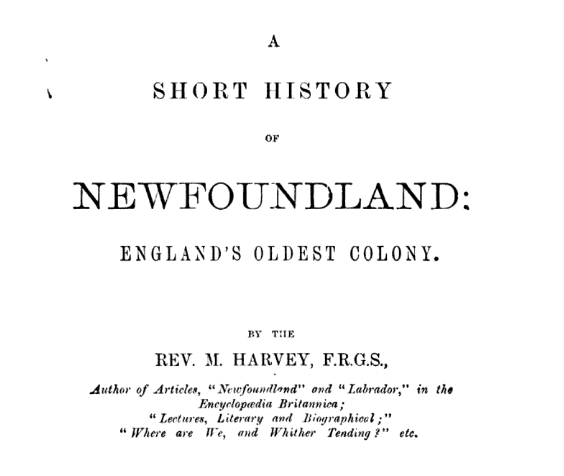A Short History of Newfoundland: England’s Oldest Colony
Moses Harvey
W. Collins, sons, & Company, limited, 1890
The Islands of St Pierre and Miquelon
These little islands, at the mouth of Fortune Bay, as we have learned in the course of their history, were ceded by Great Britain to France as a shelter for her fishermen. They are thus the only existing relics of the once great French empire in America, which stretched from Hudson’s Bay to the mouths of the Mississippi, comprising the present British possessions in North America and the great valley of the Mississippi, or about one-half of the North American continent. The fleur-de-lis had to withdraw from these regions one after the other, and now it only waves over these insignificant rocky islets. The British Lion has taken all, and left to France only the privilege of fishing on a portion of the coast of Newfoundland, with St. Pierre and Miquelon for a shelter.
To France these islands are of great value. Under the shadow of the tricolour lives here a little world of fishermen, who, amid the perils of a stormy sea, ply their avocation. From the encompassing waters France derives an important part of her food supply. To their ports Spain sends yearly enormous quantities of salt for preserving the precious gifts of the sea, which are found here in inexhaustible abundance. Thousands of French fishermen repair to these bleak islets, not only to gather the sea harvest but to train themselves by battling with the billows, for service in the navy of their country.
The group of islets consists of St. Pierre, Grande-Miquelon, and Petite-Miquelon or Langlade. The resident population now amounts to 5000. Since 1783 the Grande and Petite-Miquelon have been united by a sandbank. They are distant 135 miles from Cape Ray and Cape Luce, the south-western and south-eastern extremities of Newfoundland. Great Miquelon is not more than three-fourths of a league in length. St. Pierre is much smaller, but contains the capital of the same name, and is three times more populous than the former. The governor of the whole group resides at St. Pierre. The town is surrounded by low hills. In the fishing season it presents quite an animated appearance, being crowded with the floating population from France, which greatly exceeds the resident inhabitants. Vegetation on the islands is of the poorest description, only a few garden vegetables being grown. The climate resembles that of parts on the Gulf of St. Lawrence. Dense fogs prevail in summer and often hang over them for days in succession St Pierre is the only good harbour Fifty or sixty fishing vessels are often seen lying securely in its waters The other harbours are unsafe when certain winds blow.
More than three-fourths of all the cod-fish consumed in France come from St. Pierre and Miquelon. Official returns show that during the five years ending in 1871 the catch of cod here averaged 15,423,086 kilograms. The same returns show that, for the five years ending in 1874, the average number of vessels employed was 76; of boats, 590; the total tonnage of which was 12,386, and the number of men employed 5335.
In 1868 a French Cable Company was formed to lay a submarine cable between Brest and St. Pierre, and from the latter island to Duxbury, Massachusetts. This cable was successfully laid in 1869, three years after the successful establishment of telegraphic communication between Heart’s Content, Newfoundland, and the British Isles, in 1866. Previously, in 1858, a cable had been laid over the same route between Ireland and Newfoundland, but worked only for a short time.
FRENCH COD FISHERIES.
The Isles of St. Pierre and Miquelon, on the south coast, ceded to France by the Treaty of Paris, occupied by the French as a fishing station, have nearly 6000 inhabitants. A fleet of over 200 sail of French fishing vessels, from 100 to 400 tons, arrive here every spring from France, and make it their headquarters for the fishing season. The following figures show the quantities and value of cod-fish shipped from St. Pierre from 1879 to 1888, inclusive.
Year Quintals Value—Dollars
1879 398,326 1,372,003
1880 409,725 1,480,716
1881 374,017 1,142,719
1882 411,986 1,981,759
1883 530,045 2,230,038
1884 632,005 2,156,568
1885 820,530 2,781,744
1886 908,300 1,176,425
1887 754,770 2,507,321
1888 594,529 2,081,248
Number of Fishermen
According to the census of 1873 there were 45,845 persons employed in fishing and curing fish. At present, that number has increased to about 60,000.
In 1874 the number of able-bodied fishermen in the colony was 26,377; at present they number about 37,000.
